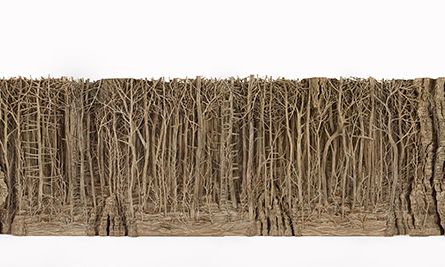Eva Jospin, Forêt (2023)
The French artist Eva Jospin says that working with the champagne house Ruinart, part of the LVMH luxury conglomerate, gave her a new perspective on the issue of climate change. Jospin visited the vineyards in the Champagne region in northern France for the latest Carte Blanche contemporary commission awarded annually by Ruinart.
The result is Promenade[s], an installation made mainly from cardboard, that is on show at the Carreau du Temple in Paris until 12 March. Jospin said at a press briefing that she saw “the impact of climate change” in Reims—located 80 miles north east of Paris—where Ruinart is based, adding that she was impressed by the way the company is addressing issues such as biodiversity by “adapting and changing the way they work”.
Asked whether she is concerned about “greenwashing”, whereby companies gloss over their green credentials, she said: “I am not perfect—there’s guilt and contradiction all the time. I am concerned about greenwashing but it is better the topic is [out] there.” She added: “I try to do art in a less invasive way; this [the environment] is not the subject of the work.”
Jospin has worked with cardboard, an environmentally friendly material, for more than ten years, carving and creating elaborate sculptures such as Details d’Une Forêt (2011), which shows a section of a forest in bas-relief. In Paris, she is showing a new sculptural work, Forêt A/B/C/D (2023), which references Ruinart’s biodiversity project at Taissy vineyard, where grape vines have been replaced by 25,000 trees.
How long cardboard can be conserved is debatable, though. “It is much more resistant than I thought because some of the pieces are old. It is not going to go past 500 years," she said. "You always have this idea of a second life as everything [is] transformed by us; cardboard is like that. It will be for future generations to decide [if they want to preserve it]; if not, they can throw it to the garbage."
Ruinart has collaborated with artists since 2008 for its Carte Blanche series, presenting works by high-profile figures such as David Shrigley, Vik Muniz and Liu Bolin. The commission is part of a wider artistic programme leading up to the 300th anniversary of the champagne house in 2029, encompassing other initiatives such as a collaboration with the Argentine artist Tomás Saraceno in 2021, which involved launching an Aerocene balloon sculpture over Ruinart’s vineyards.
Jospin, the daughter of the former French prime minister Lionel Jospin, was inspired by the vineyards in Reims and the ancient chalk cellars known as crayères, which are listed as a Unesco World Heritage site. “In the chalk cathedrals of the crayères, home to Maison Ruinart’s cellars since the late 18th century, she detected traces of the ancient, secret rituals that link the labour of the human hand to those underground architectural interiors and the vines ripening in the sun,” says a Ruinart statement.
“I made several trips to Reims where it is interesting to follow the seasons,” Jospin said. “In February it was very dry and very naked but there was this moment when things started growing again. And you come back for the harvest. I was able to discover this repetition of little gestures—all the steps in the crayères, the turning [of the bottles]—this ritual is really beautiful. There are many steps, layers of action, that create the final product.”
The idea of the contoured Champagne landscape, and the layers of the chalk pits, are reflected in a series of intricate cardboard installations known as chefs d’oeuvre, which invite visitors to explore the region in miniature. The architectural elements of the chefs d’oeuvre also draw upon the Cathédrale Notre-Dame de Reims, a Gothic art landmark where the kings of France were crowned.
Jospin also evokes the cartography of the area through a series of relief drawings on mounted canvas displayed at the Carreau du Temple along with landscape-like embroideries made from silk threads. All of these elements pivot around a carmontelle, a roll of paper stretched between two cylinders that unfurls with the turn of a handle. The device is named after Louis Carrogis Carmontelle, the 18th-century set designer; Jospin’s version reveals a panorama of trees and vines reflecting further her Ruinart experience.
Eva Jospin, Carmontelle (2023)
Parts of the Promenade[s] work will also be displayed at major art fairs this year, including Frieze London in October. “We can mix [the works] and create a new scenography for each art fair,” Jospin said, adding that she is preparing for a new show at the Fondation Thalie in Brussels (15 April-15 July), which will also address ecological issues.

